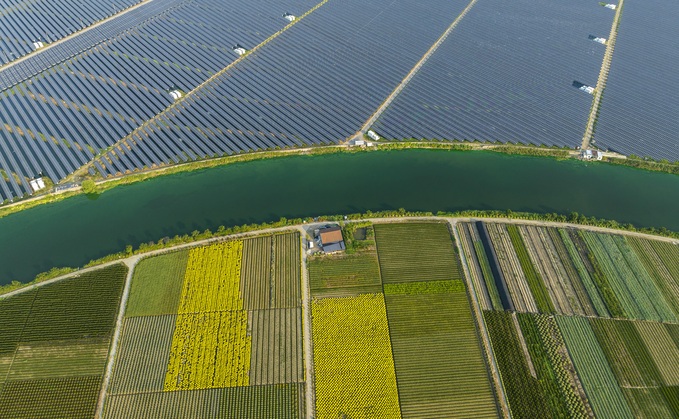
LGIM is committed to achieving net-zero greenhouse gas emissions by 2050 across all assets under management. Here’s how we’re targeting this goal within different investment capabilities.
This year has been characterised by geopolitical and market upheaval. It has also demonstrated the importance of energy to the global economy. We believe the most effective way to achieve energy security over the long term, and avoid a climate catastrophe, is by achieving net-zero emissions.
To this end, we have set concrete targets; our ESG strategies are increasingly incorporating net-zero considerations; we continue to engage investee companies - with consequences, should they fail to act - and we are investing in ‘green' opportunities.
In this article, we outline the key features of our approach across different asset classes and investment capabilities.
Decarbonisation pathways in index strategies
Index strategies can offer clearly defined decarbonisation pathways. There are a few ways in which to decarbonise index strategies, including exclusions and capital reallocation; we deploy both approaches.
Exclusions - also known as negative screening - involve avoiding specific stocks or industries represented in an index. Some investors prefer this approach as it is transparent, easy to communicate and can offer peace of mind.
As the level of exclusions increase, however, the adjusted index often strays from its parent benchmark, deviating from delivering a market-like, risk-return profile. We also believe that engaging with companies is a more effective way to achieve systemic change than deploying blanket exclusions.
Meanwhile, capital reallocation can involve reducing emissions intensity by a fixed percentage relative to a parent benchmark. The index portfolio would then continue to be decarbonised by additional percentage points year-on-year. The goal is to reallocate the exposure from high to low-carbon intensive stocks, while keeping active weights within certain geographic, sectoral and security-level limits. Although it is possible to decarbonise a global index with a low tracking error, our analysis indicates tracking error rises sharply when decarbonisation increases beyond 50%.
In our view, a potentially powerful route to decarbonisation of index portfolios involves a combination of exclusions, where minimum standards are not met, with greater reallocation of capital between climate ‘winners' and ‘laggards'.
Targeting laggards in active equity portfolios
A broad sweep of companies is critical to the energy transition - not just those with solid climate credentials.
We recognise that climate laggards will also need to achieve net-zero emissions or risk becoming stranded assets. So within our active equity climate transition strategy, we utilise our LGIM Destination@Risk framework to identify and invest in those laggards, where we see potential to help them advance the energy transition and reach net-zero goals.
Indeed, we can unlock value to effect real-world outcomes, in our view, by engaging and partnering with such companies, drawing on the combined expertise of LGIM's Investment Stewardship and Investments teams. We believe we can use our size and scale to support the transition to a low-carbon economy, even within sectors like energy and materials that are typically excluded from many active, climate-aligned strategies.
Climate metrics for credit
Managing a credit portfolio with a dual target of financial performance and net-zero objectives requires a thoughtful optimisation exercise between yield- and climate-related considerations.
LGIM's net-zero framework is applied to such portfolios, with an emphasis on the reduction of GHG emissions versus the reference benchmark and an improvement in temperature alignment over time. As such, our net-zero portfolios are aimed at achieving relative and measurable decarbonisation, while also investing in issuers on the pathway to net zero by 2050.
Our targets capture past and future improvements in climate-related metrics. This means active managers can look for alpha opportunities in sectors with high GHG emission intensity, rather than excluding them entirely. As these sectors will continue to require capital to transition towards net zero, we believe issuers transitioning adequately should eventually benefit from a lower risk premium. This is because market participants are likely to start repricing climate-related risks and model their impact on credit ratings.
We also establish targets for our net-zero portfolios at the outset - and make them more stringent over time - as well as engaging with laggards and closely monitoring progress by issuers.
Harnessing climate science in multi-asset
In our multi-asset solutions, we use both top-down and bottom-up tools to align funds with LGIM's net-zero framework, in addition to engagement with companies within all physical holdings, whether held directly or indirectly through other building block funds.
We start by setting interim decarbonisation targets for 2025 and 2030 relative to an end-2019 reference point. Our plan is to review progress and set out new five-year targets towards 2050. Using this process, we aim to ensure the decarbonisation pathway responds to improvements in available climate science, technology and investment solutions.
These targets are currently expressed as a reduction in carbon footprint, but in the future may also reference specific temperature alignment. They are derived in part from accepted industry frameworks, as well as insights and tools from LGIM's Climate Solutions team.
We are fortunate to access a wide range of LGIM index and active building blocks across equities, credit, direct property and emerging market debt, which often have decarbonisation commitments of their own. Many also exclude radically misaligned companies, such as those that generate more than 20% of their revenues from coal mining and that fail to respond adequately to our Climate Impact Pledge, a targeted engagement programme. We apply the same exclusions to all our direct corporate security holdings.
Finally, we also invest in carefully constructed targeted baskets to help us reduce the carbon footprint of our alternative holdings. These focus on positive selection within sustainable timber and low-carbon infrastructure.
The start of a journey
While asset managers have made material progress in setting climate targets and innovating to meet client needs, we recognise that there is much further to go. That's why at LGIM, in addition to the steps outlined above, we are also collaborating with policymakers and other stakeholders to make a net-zero future not just possible, but probable.
Important Information
The value of an investment and any income taken from it is not guaranteed and can go down as well as up, you may not get back the amount you originally invested. The views expressed are those of LGIM as at 1 November 2022. The Information in this document (a) is for information purposes only and we are not soliciting any action based on it, and (b) is not a recommendation to buy or sell securities or pursue a particular investment strategy; and (c) is not investment, legal, regulatory or tax advice. Legal & General Investment Management Limited. Registered in England and Wales No. 02091894. Registered Office: One Coleman Street, London, EC2R 5AA. Authorised and regulated by the Financial Conduct Authority, No. 119272.
This post is funded by LGIM.






